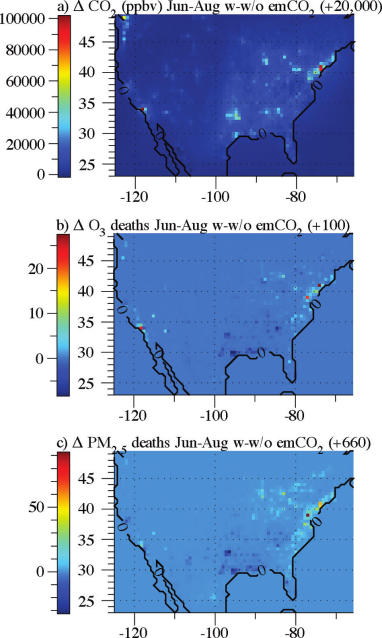Enhancement of Local Air Pollution by Urban CO2 Domes
MARK Z. JACOBSON
Department of Civil and Environmental Engineering, Stanford University, Stanford, California 94305-4020
Received October 3, 2009. Revised manuscript received December 21, 2009. Accepted March 2, 2010.
Data suggest that domes of high CO2 levels form over cities.
Despite our knowledge of these domes for over a decade, no
study has contemplated their effects on air pollution or
health. In fact, all air pollution regulations worldwide assume
arbitrarily that such domes have no local health impact, and carbon
policy proposals, such as “cap and trade”, implicitly assume
that CO2 impacts are the same regardless of where emissions
occur. Here, it is found through data-evaluated numerical
modeling with telescoping domains from the globe to the U.S.,
California, and Los Angeles, that local CO2 emissions in
isolation may increase local ozone and particulate matter.
Although health impacts of such changes are uncertain, they
are of concern, and it is estimated that that local CO2 emissions
may increase premature mortality by 50-100 and 300-1000/
yr in California and the U.S., respectively. As such, reducing
locally emitted CO2 may reduce local air pollution mortality
even if CO2 in adjacent regions is not controlled. If correct, this
result contradicts the basis for air pollution regulations
worldwide, none of which considers controlling local CO2
based on its local health impacts. It also suggests that a “cap
and trade” policy should consider the location of CO2 emissions,
as the underlying assumption of the policy is incorrect.
Introduction
Although CO2 is generally well-mixed in the atmosphere,
data indicate that its mixing ratios are higher in urban than
in background air, resulting in urban CO2 domes (1–6).
Measurements in Phoenix, for example, indicate that peak
and mean CO2 in the city center were 75% and 38-43% higher,
respectively, than in surrounding rural areas (2). Recent
studies have examined the impact of global greenhouse gases
on air pollution (7–13). Whereas one study used a 1-D model
to estimate the temperature profile impact of a CO2 dome
(3), no study has isolated the impact of locally emitted CO2
on air pollution or health. One reason is that model
simulations of such an effect require treatment of meteo-
rological feedbacks to gas, aerosol, and cloud changes, and
few models include such feedbacks in detail. Second, local
CO2 emissions are close to the ground, where the temperature
contrast between the Earth’s surface and the lowest CO2 layers
is small. However, studies have not considered that CO2
domes result in CO2 gradients high above the surface. If locally
emitted CO2 increases local air pollution, then cities, counties,
states, and small countries can reduce air pollution health
problems by reducing their own CO2 emissions, regardless
of whether other air pollutants are reduced locally or whether
other locations reduce CO2.
Conclusions:
For the U.S. as a whole, the correlations between increases
in CO2 and increases in O3 and PM2.5 premature mortality
were also both visually apparent (Figure 5) and statistically
significant (r ) 0.31, p < 0.0001 for ∆CO2 vs ∆O3 mortality;
r ) 0.32, p < 0.0001 for ∆CO2 vs ∆PM2.5 mortality). The Jun-
Aug correlation between ∆CO2 and ∆PM2.5 concentration
(r ) 0.1, p < 0.0001) was weaker than that between ∆CO2 and
∆PM2.5 mortality, since local CO2 fed back to meteorology,
which fed back to PM2.5 outside of cities as well as in cities,
but few people were exposed to such changes in PM2.5 outside
of cities. Nevertheless, both correlations were strongly
statistically significant.

The annual premature mortality rates due to emCO2 in
the U.S. were ∼770 (300-1000), with ∼20% due to ozone.
This rate represented an enhancement of ∼0.4% of the baseline
mortality rate due to air pollution. With a U.S. anthropogenic
emission rate of 5.76 GT-CO2/yr (Table S2), this corresponds
to ∼134 (52-174) additional premature mortalities/GT-CO2/
yr over the U.S. Modeled mortality rates in Los Angeles for the
Los Angeles domain were higher than those for Los Angeles in
the California or U.S. domains due to the higher resolution of
the Los Angeles domain; thus, mortality estimates for California
and the U.S. may be low.
Implications
Worldwide, emissions of NOx, HCs, CO, and PM are regulated.
The few CO2 regulations proposed to date have been justified
based on its large-scale feedback to temperatures, sea levels,
water supply, and global air pollution. No proposed CO2
regulation is based on the potential impact of locally emitted
CO2 on local pollution as such effects have been assumed
not to exist (21). Here, it was found that local CO2 emissions
can increase local ozone and particulate matter due to
feedbacks to temperatures, atmospheric stability, water
vapor, humidity, winds, and precipitation. Although modeled
pollution changes and their health impacts are uncertain,
results here suggests that reducing local CO2 may reduce
300-1000 premature air pollution mortalities/yr in the U.S.
and 50-100/yr in California, even if CO2 in adjacent regions
is not controlled. Thus, CO2 emission controls may be justified
on the same grounds that NOx, HC, CO, and PM emission
regulations are justified. Results further imply that the as-
sumption behind the “cap and trade” policy, namely that CO2
emitted in one location has the same impact as CO2 emitted
in another, is incorrect, as CO2 emissions in populated cities
have larger health impacts than CO2 emissions in unpopulated
areas. As such, CO2 cap and trade, if done, should consider the
location of emissions to avoid additional health damage.